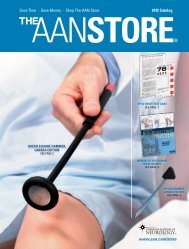Read the Case-Based Curriculum for Neurology Residents.
Read the Case-Based Curriculum for Neurology Residents.
Read the Case-Based Curriculum for Neurology Residents.
You also want an ePaper? Increase the reach of your titles
YUMPU automatically turns print PDFs into web optimized ePapers that Google loves.
such as topical capsaicin and narcotics of various strengths may also be used. Many physicians<br />
adopt an "analgesic ladder" approach to pain management, often using salicylares and NSAIDs,<br />
occasionally selecting from a shon list of favored adjuvants such as amitriptyline <strong>for</strong> chronic use,<br />
reserving "weak" opioid mixtures (e.g., acetaminophen with codeine) <strong>for</strong> brief courses of strictly<br />
limited quantity <strong>for</strong> acute severe pain, and rarely ifever using "strong" opioids (e.g.,<br />
hydromorphone) (2). Published guidelines <strong>for</strong> an "adequate" dnrg trial <strong>for</strong> each analgesic<br />
empirically tried include candid discussion of <strong>the</strong> need <strong>for</strong> trial and error, drug titration one at a<br />
trme, initiadng with smallest-size available oral tablet, increasing every 3 to 7 days as tolerated<br />
and required, close communication between patient and staff weekly or biweekly, and increasrng<br />
until satisfaction or intolerable side effects are reported. Hisrorica.l analgesic trials must be<br />
deemed inadequate and inconclusive if dose incrcase was curtailed shon ofintended analgesic<br />
level <strong>for</strong> reasons o<strong>the</strong>r than intolerance, or if intolerance followed too-fast titration or too many<br />
drugs being used simulraneously (3). The goal of analgesic trials, individually and in<br />
combination, is ro provide partial, incremental analgesia when a cure is not possible (4).<br />
GRPS is a new rerm <strong>for</strong> a subclass of neuropathic pain<br />
"causalgia"<br />
syndromes traditionally termed<br />
and<br />
"reflex symparheric dystrophy" (RSD), which often but not invariablv follo* ^<br />
subacute sequela of trauma and o<strong>the</strong>r conditions (5). Neurologist Weir Mitchell usei "causalgia"<br />
to describe a syndrome including severe buming pain in <strong>the</strong> hand after major partial injury to <strong>the</strong><br />
brachial plexus during <strong>the</strong> Civil War. The diagnostic weight of different fnysical and iialnostic<br />
signs observed in various combinations in rhe "syndrome" varies grcatly amtng authoritie;, bur<br />
by definition, causaigia or CRPS-II requires an identifrable nerve lesion usually in a ',named"<br />
peripheral nerve, plexus or root structure. The pain is severc, persistent, and usually burning in<br />
qua.lity' including hyperargesia (minimar stimulus evokes disproportionate pain), irodynia<br />
(innocuous stimulus like touch changes to noxious dyses<strong>the</strong>sia such as buming), and hyperpathia<br />
(temporal su[rmadon of repear srimuli into crcscendo pain); and is associated-with .,".ying'<br />
amounts of edema: cutaneous changes of color, temperature, sweat, and nail growttr l"Lofmc<br />
changes"); stiffness; local osteoporosis; and eventual fixed contracrurcs. ftielain sustai;ng<br />
mechanism is controversial, some implicating sympa<strong>the</strong>tic effercnts at certain stages, thus<br />
advocating symparhetic blocks <strong>for</strong> diagaosis and treatment. o<strong>the</strong>rs vigorously argue <strong>for</strong> a<br />
significant psychological sustaining mechanism. A similar constellation of sympioms and signs,<br />
not associated with an identifiable nerve lesion, constitutes RSD or cRpSl. Meaningful use of<br />
CRPS (or RSD/causalgia) terminology entails making a distincrion between causalgia and RSD,<br />
and <strong>the</strong>re<strong>for</strong>e demands a neurologically sophisticated examination, imaging, neurodiagnostic and<br />
o<strong>the</strong>r studies.<br />
cNP is chronic pain nor associated with a marignancy. It encompasses many types of<br />
moderate to severe chronic pain syndromes, including neurogenic (painful polyneuropithies,<br />
zoster, trigeminal neuralgia and o<strong>the</strong>r facial pains, CRpS), inractable headache, spinal pain<br />
(including "failed back syndrome"), arthritis, bums, sickle cell, AIDS rclated, and pelviCpain.<br />
Designating <strong>the</strong>se syndromes as chronic nonmalignant pain distinguishes <strong>the</strong>m from cancir<br />
associated pain, where recent experience with opioids in cancer centers has established <strong>for</strong> <strong>the</strong>m<br />
a more accepted role in <strong>the</strong> medical community and morc secure standing in law and regulations.





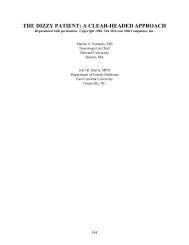

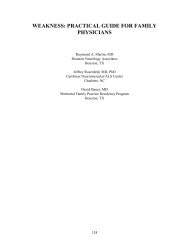
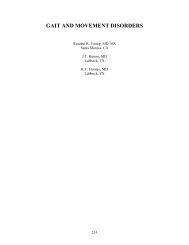
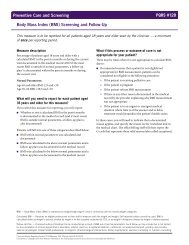
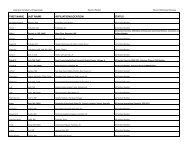
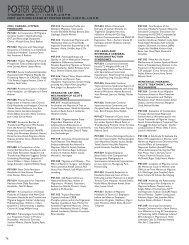
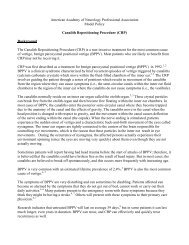
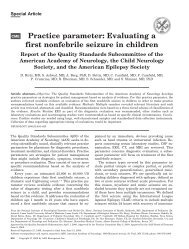
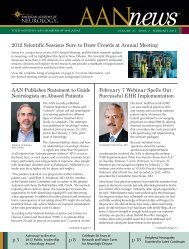
![[Click here and type date] - American Academy of Neurology](https://img.yumpu.com/8582972/1/190x245/click-here-and-type-date-american-academy-of-neurology.jpg?quality=85)
